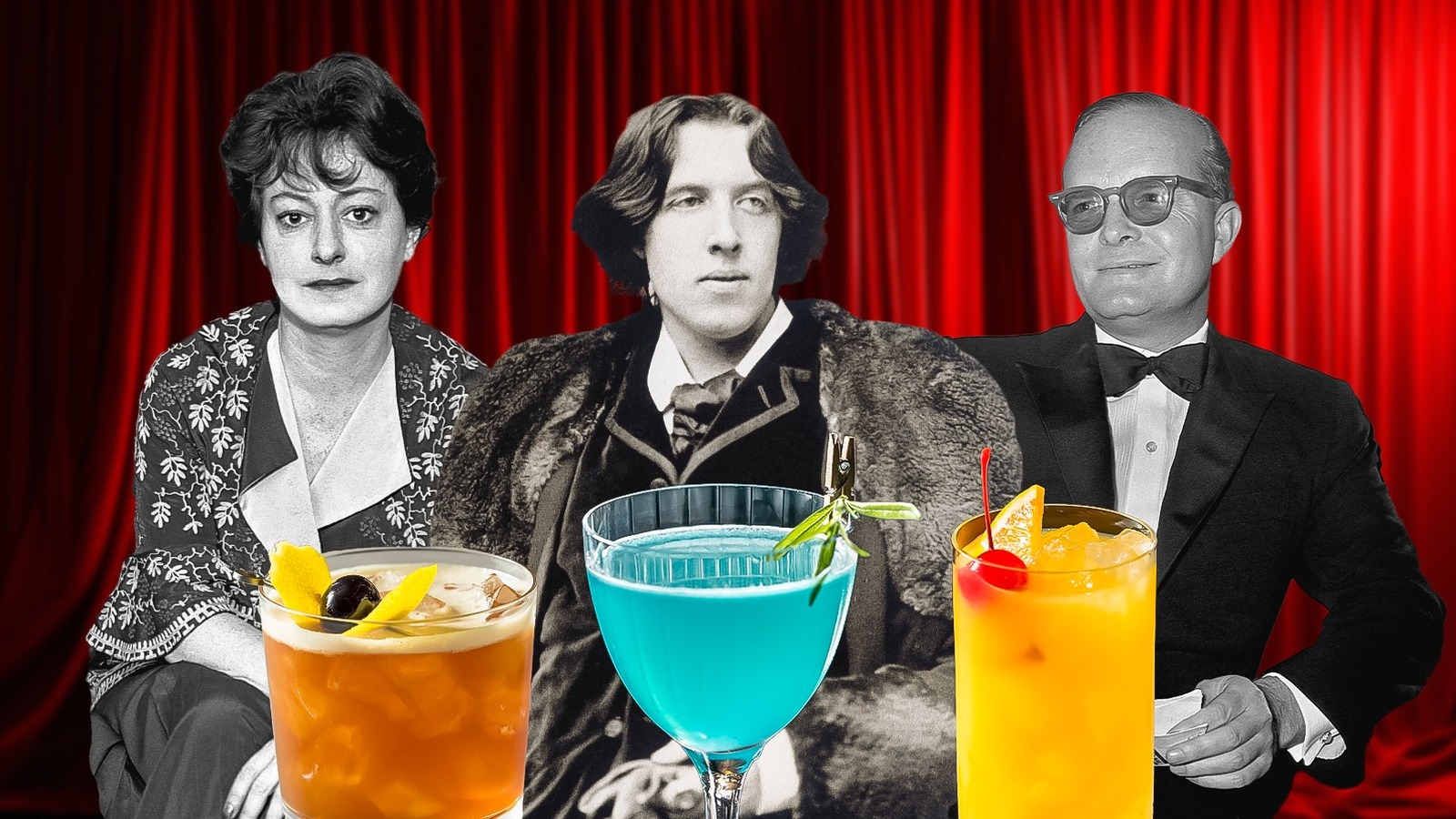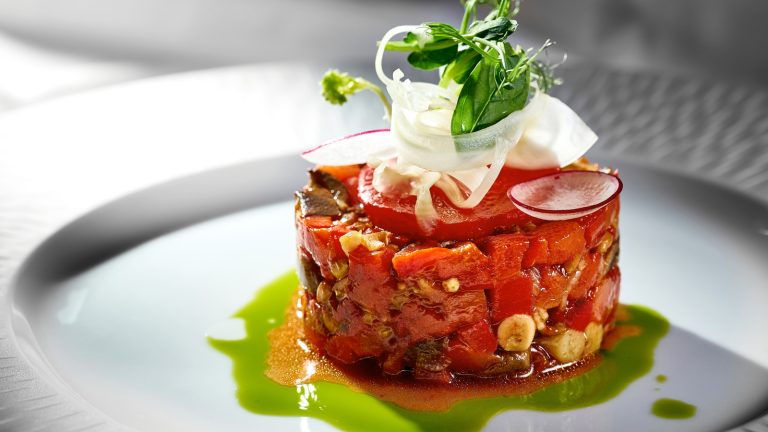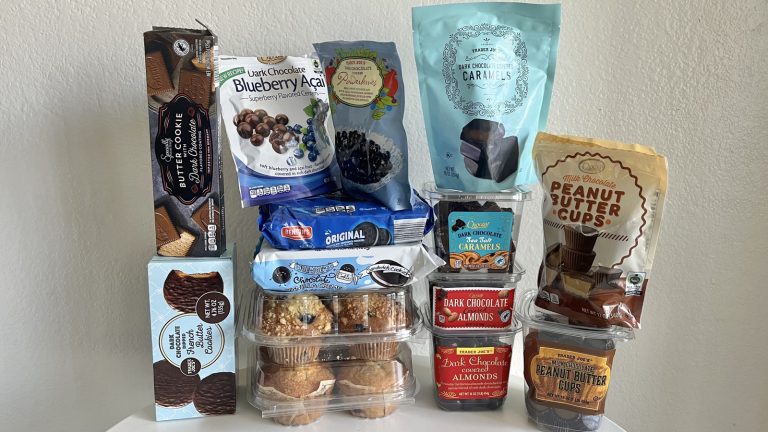There’s a stereotype woven throughout literary history, and that is the idea of the tortured and boozy writer. From the smoky cafes of Paris to the raucous New York speakeasies of the Jazz Age, the image of writers wrestling with their prose while drinking liquor is one that persists and, admittedly, fascinates me. When it came time for me to write my second book, a travel memoir titled “Call You When I Land,” I encountered my fair share of writer’s block and so decided to turn to some of my literary heroes and the very same cocktails that helped fuel their own stories in hopes of finding a libation that might inspire my own words to flow.
In researching the drinks of choice for some of history’s greatest writers, I realized that many of the cocktails they once enjoyed now offer a fascinating glimpse into their individual personalities, preferences, and even their writing style. Ernest Hemingway’s custom daiquiris, for example, mirror his minimalist and direct prose; F. Scott Fitzgerald’s refreshing gin rickeys captured the bittersweet glamour of the Jazz Age he has come to represent and even made appearances in his magnum opus, “The Great Gatsby,” while his wife’s drink of choice, the vodka lemonade, was a perfect homage to Zelda Sayre’s Southern belle roots.
From the smoky haze of the absinthe Oscar Wilde once loved to the strong, bracing chill of the vodka martinis Sylvia Plath would drink alongside Anne Sexton, these beverages were silent witnesses to moments of brilliance, despair, and unrelenting ambition of some of history’s most prolific writers.
Ernest Hemingway & the daiquiri
Ernest Hemingway was one of the most influential writers of the 20th century, authoring such classics as “The Old Man and the Sea”and “For Whom the Bell Tolls.” He was known for his clear and direct writing style, which was often characterized by an absence of flowery adjectives and excessive adverbs. Instead, Hemingway’s writing was punchy, direct, and minimalist, a style of writing that was so novel it earned him the Nobel Prize for Literature in 1954.
When Hemingway found himself living in Havana, Cuba, he was said to be a regular at El Floridita, where he developed a particular fondness for the daiquiri, even going on to request a custom version: no sugar, double rum, and plenty of fresh lime and grapefruit juice. Dubbed the “Papa Doble,” Hemingway’s daiquiri was a sharp, potent cocktail that mirrored his writing: it was clean, bold, and unflinching. His preference for a stripped-down, no-nonsense drink aligned perfectly with the minimalism that often marked his literary style. Hemingway claimed he could drink a dozen of these modified daiquiris without feeling drunk, a boast that reinforced his larger-than-life persona.
F. Scott Fitzgerald & the gin rickey
F. Scott Fitzgerald, one of my favorite authors, remains one of the most celebrated voices of the Jazz Age, capturing its glamour, excess, and underlying despair in novels such as “The Great Gatsby,” “Tender Is the Night,” and “This Side of Paradise.” There has always been a fascination surrounding Fitzgerald and his glamorous, albeit turbulent, marriage to Zelda Fitzgerald, with themes of longing, loss, and alcoholism pervading his fiction. When it came to alcohol, Fitzgerald famously said, “First you take a drink, then the drink takes a drink, then the drink takes you.”
When it came to his cocktail of choice, Fitzgerald had an affinity for the gin rickey — a refreshing mix of gin, lime juice, and soda — which would have proven a fitting match for his love of high society. One reason Fitzgerald is said to have favored this light cocktail was for practical reasons: it left little lingering scent on the breath. In the glamorous world of 1920s high society, maintaining an air of polish was crucial, and the gin rickey’s clean and tart profile, with minimal smell, would have proved a worthy writing companion.
If there’s any doubt about Fitzgerald’s reverence for the gin rickey, one need only revisit “The Great Gatsby” (one of my favorite books), where Fitzgerald’s drink of choice appears within its pages, where the characters of Tom and Daisy take “long, greedy swallows” of their gin-and-lime libations.
Sylvia Plath & the vodka martini
Sylvia Plath remains one of the most influential and haunting voices in both poetry and literature. She is best known as the author of the posthumously published poetry collection, “Ariel,” and her semi-autobiographical novel, “The Bell Jar.” Her writing would often touch on heavier themes such as mental illness, identity crisis, and existential despair with a candid intensity that helped usher in a new confessional style of poetry. In short, Plath was a true tortured artist, and her confessional style of writing paired with her emotional honesty left an indelible mark on the world of poetry and literature as we know it today.
Sylvia Plath and fellow poet Anne Sexton were said to be bonded by both poetic brilliance and a penchant for vodka martinis. After poetry seminars, the two would head to the Ritz-Carlton in Boston and order at least three vodka martinis each, where they would chat about everything from their work to the instructor of their poetry seminar. Like their poetry, their vodka martini of choice was direct and barebones, calling simply for vodka, dry vermouth, and a lemon twist or an olive garnish. When it came to moving past my own writer’s block, I took a page from Plath and Sexton’s book, finding my preferred cocktail to be the classic dirty vodka martini.
Truman Capote & the vodka screwdriver
Truman Capote is best known for his popular books “Breakfast at Tiffany’s” and “In Cold Blood,” the latter of which was a groundbreaking nonfiction novel that redefined the true crime genre by combining journalism with narrative storytelling. While Capote was known for his flamboyant and larger-than-life public persona among New York’s high society, of which he was a fixture, his writing proved to be more nuanced and vulnerable, revealing deep wells of emotion and glimpses into the demons he unfortunately struggled with for much of his life, including alcoholism.
When it came to his drink of choice, Capote was known to appreciate the simplicity of the vodka screwdriver: a mixture of vodka and orange juice, an easy-to-sip cocktail he endearingly called “my orange drink” during his lifetime. While the vodka screwdriver is a simple cocktail, its history is a little more complex, with an unclear origin. One theory is that the screwdriver can be attributed to marines during World War II, who were said to occasionally add vodka to their orange juice.
As far as Truman Capote is concerned, while he loved screwdrivers and remained loyal to vodka, he did not remain as loyal to his mixers. On occasion, he was known to swap out the orange juice for soda and grapefruit juice.
Oscar Wilde & absinthe
Oscar Wilde was an Irish writer, poet, and playwright who reached literary fame with his plays “The Importance of Being Earnest” and “An Ideal Husband” — both of which are celebrated for their satire and brilliant dialogue — as well as his only novel, “The Picture of Dorian Gray.” When it came to drinking, Wilde was said to have loved absinthe.
Nicknamed “the green fairy,” the hallucinogenic component of absinthe, brought on by wormwood, promised visions and inspiration that could help fuel creativity. Wilde famously described the absinthe experience in stages: “After the first glass, you see things as you wish they were. After the second, you see things as they are not. Finally, you see things as they really are, and that is the most horrible thing in the world.”
While absinthe was made illegal in the United States due to its hallucinogenic qualities (the psychoactive effects are caused by thujone, which is derived from wormwood), today you can find absinthe sold in America, provided that it is wormwood-free. In other words, the absinthe Oscar Wilde once enjoyed is difficult to find in the United States nowadays, but in Europe, you can still find absinthe containing wormwood, with the legal threshold for thujone in the EU set at 35 milligrams.
Zelda Fitzgerald & the vodka lemonade
Like many women of her time, Zelda Fitzgerald’s legacy was unfortunately overshadowed by that of her husband, F. Scott Fitzgerald, who considered his wife to be his muse. Frequently distilled down to frivolous labels such as socialite, party girl, and the “first flapper” — more importantly, Zelda Fitzgerald was a writer, dancer, and artist in her own right. While Zelda’s vivid personality and rebellious spirit helped define the glamour and excess of the Roaring Twenties, it’s this very reputation, paired with her husband’s literary prowess, that often eclipsed her own artistic ambitions.
Instead, Zelda was considered a complicated woman, remembered as being in constant competition with Hemingway for Scott’s attention, while struggling with alcoholism herself. Zelda authored her own semi-autobiographical novel, “Save Me the Waltz,” in 1932, which candidly depicted the tensions in her marriage and her personal quest for identity. While Zelda’s husband preferred the clean, crisp taste of a gin rickey, Zelda was said to favor a vodka lemonade, a nod to her Southern belle roots and Montgomery, Alabama, from which she came.
Dorothy Parker & the whiskey sour
One of the founding members of the famed “Vicious Circle,” which once gathered at the Round Table at New York’s historic Algonquin Hotel back in the 1920s and 30s, Dorothy Parker was a poet, critic, and satirist celebrated for her cutting wit, caustic humor, and unflinching observations. Her writing, which included “Enough Rope” and “Big Blonde,” often explored darker themes of loneliness and the gap between societal expectations and one’s personal reality, making for timely observations that still resonate today.
While Parker is remembered for her dazzling words, her layered writing makes her one of the most complex voices of American literature. So, when it came to her beverage of choice, it should come as no surprise that Parker gravitated towards a cocktail that struck the same complexities as her work: the whiskey sour. This classic and historic cocktail blends whiskey, lemon, and sugar, resulting in a flavor profile that is both tart and potent. Whether she was crafting biting poems or skewering societal hypocrisy, Parker’s drink of choice tended to embody her literary voice — it was elegant, complex, punchy, and laced with just the right amount of bitterness.
While Parker clearly enjoyed her whiskey sours, it’s also worth noting that her writing mentions her love of champagne. As shown in her poem, “Inventory,” Parker wrote: “Three be the things I shall never attain: Envy, content, and sufficient champagne.”
Jack Kerouac & the mezcal margarita
Jack Kerouac was a novelist and poet best known as the founding father of the Beat Generation, a literary movement that rejected conventional values on the altar of celebrating personal freedom and exploration instead. His most famous work, “On the Road,” captured the restless spirit of postwar America and became a defining novel for an entire generation. While his writing style, often referred to as “spontaneous prose,” focused on sharing raw emotions and the pursuit of authentic experiences, his fascination with spirituality, jazz, and the American landscape shaped much of his work, including “The Dharma Bums” and “Big Sur.”
During his life, Kerouac traveled to Mexico more than a few times, where he fell in love with the smoky mezcal margarita, preferring the smokier mezcal to the classic tequila margarita. Combining fresh lime juice, triple sec, and mezcal, the mezcal margarita is typically served in a rocks glass with a salt rim.
Hunter S. Thompson & the Singapore Sling
Hunter S. Thompson was a journalist-turned-author who is best known as being the pioneer of “gonzo journalism,” a style of writing that blends fact, fiction, and personal experience. It goes without saying that Hunter S. Thompson was a juggernaut who broke traditional journalistic rules by placing himself at the center of a story, offering keen observations through his raw, unfiltered voice and experiences. His book, “Fear and Loathing in Las Vegas: A Savage Journey to the Heart of the American Dream,” was by far his most famous work and one that captured the disillusionment of the American Dream through his own drug-fueled odyssey in Las Vegas.
Not only does Thompson’s autobiographical novel offer a chaotic glimpse into his wild journey, but it also provides readers with a look at one of his preferred cocktails: the Singapore Sling. This historic cocktail, a colorful blend of gin, sugar, lime juice, and cherry brandy, has undergone multiple iterations, with some Singapore Sling recipes even adding pineapple, grenadine, or red wine. In his book, Hunter S. Thompson wrote of the afternoons spent indulging in Singapore Slings, wasting away afternoons with his friends in tow: “sitting there in the Polo Lounge — for many hours, drinking Singapore Slings with mescal on the side and beer chasers.
James Baldwin & bourbon neat
James Baldwin was an American novelist, essayist, and activist whose work profoundly reshaped conversations about race, identity, and social injustices happening in the United States. Originally born in Harlem, Baldwin’s early experiences with racism and poverty had a profound impact on his writing, including his book, “The Fire Next Time.” While James Baldwin spent much of his life living abroad, especially in France, he never wavered in his commitment to speaking out about the civil rights struggles happening back in the United States.
When back in New York, Baldwin — like many other writers of the time, including Jack Kerouac and Dylan Thomas — was said to frequent the historic White Horse Tavern in New York City and order himself a bourbon neat. New York’s second-oldest bar, originally opened in 1880, became the go-to spot for writers and artists of the 1950s, including Baldwin, who liked to keep it simple with two ounces of bourbon served in a rocks glass.
Speaking of writers, the White Horse Tavern, which still has its original wood paneling and tin roof, is said to be haunted by the ghost of Welsh poet Dylan Thomas, who famously died after leaving the White Horse Tavern following a whiskey binge in 1953.
Anthony Bourdain & the Negroni
By far the most recent writer on this list, the late and great Anthony Bourdain was an acclaimed storyteller, television host, chef, and travel documentarian who rose to fame following the publication of his bestselling memoir, “Kitchen Confidential: Adventures in the Culinary Underbelly,” an unfiltered look behind the scenes of professional kitchens that combined humor, grit, and poignant insight. Following the success of his memoir, Bourdain set out to write one of my personal favorite books, “A Cook’s Tour: In Search of the Perfect Meal,” while simultaneously filming his first travel show of the same name. From then on, Bourdain’s television career as a travel host was cemented with his subsequent shows, “No Reservations” and CNN’s “Parts Unknown.”
During his lifetime, Bourdain, who spent his life connecting with cultures through food and drink, made it known that he was a devoted fan of the Negroni, a cocktail he considered perfect, even calling it one of his all-time favorite drinks. “A Negroni is a perfect drink, as far as I’m concerned,” said Bourdain in an interview with Barron’s at its 2016 annual American Craft Council Fellowship Awards. “You know, it’s three liquors that I’m not particularly interested in. I’m not really a gin drinker, don’t like Campari, and straight vermouth leaves me cold, but put ’em together with a slice of orange … it works.” Made with gin, Campari, and vermouth, the Negroni strikes a perfect balance between bitter, sweet, and botanical notes.
Maya Angelou & sherry
Maya Angelou was a poet, memoirist, and civil rights activist whose work has become a cultural touchstone, capturing the struggles and triumphs of the Black community in the United States. She is best known for her autobiographical series, beginning with “I Know Why the Caged Bird Sings,” and her writing style, which blends narrative with social commentary, particularly examining racism, trauma, and resilience.
In an interview with The Paris Review, Angelou shared her writing ritual, which took place in hotel rooms, accompanied by nothing more than a dictionary, an ashtray, yellow legal pads, and a bottle of sherry. In response to the interviewer asking if the fortified wine Angelou preferred was an end-of-day tradition or something to fuel the imagination, Angelou replied simply: “I might have it at six-fifteen a.m. just as soon as I get in, but usually it’s about eleven o’clock when I’ll have a glass of sherry.” Much like her writing, the warmth and depth of sherry seems a perfect metaphor for Maya Angelou’s rich storytelling, dripping with warmth, wisdom, and strength.





